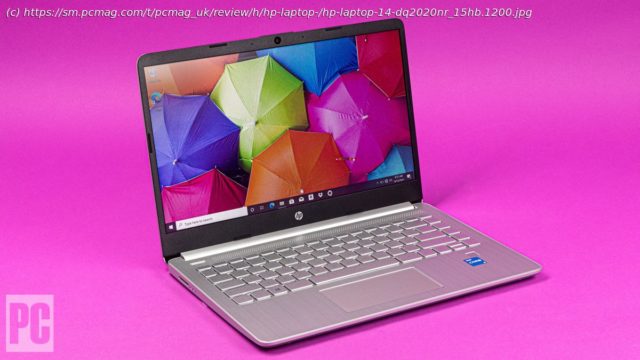Economy Windows model is an uptick from a basic Chromebook
You probably know that HP’s Pavilion brand is for consumer PCs priced and positioned below its upscale Envy and Spectre lines. But Pavilion is only the second-lowest rung on HP’s notebook-PC ladder. Its budget laptops have no brand at all, just a generic family name: „HP Laptop.“ Take the HP Laptop 14-dq2020nr ($428 at Amazon and Walmart). The 14-dq2020nr is every inch an economy model, with just 4GB of RAM and a 128GB solid-state drive—half the memory and storage we consider today’s minimum—but it’s a workable introduction to Windows if you don’t want to consider a Chromebook. Four Cores and S Mode Though some online listings say the 14-dq2020nr has a dual-core Intel Core i3-1115G4, our test unit actually clicks that up to a quad-core,2.0GHz (3.7GHz turbo) Core i3-1125G4 processor with Intel integrated UHD Graphics. The 14-inch, non-touch screen offers full HD (1,920-by-1,080-pixel) resolution. The default operating system is Windows 10 Home in S Mode, which restricts software installations to programs from the Windows Store; a few clicks in the Store perform an irreversible switch to regular Windows 10 Home, which we made in order to install our benchmark test software. (Photo: Molly Flores) Clad in silver plastic, the HP Laptop measures 0.71 by 12.8 by 8.9 inches and weighs 3.24 pounds, making it just a bit heftier than the rival Asus VivoBook S14 (0.63 by 12.8 by 8.4 inches and 3.09 pounds). A chrome HP logo decorates the lid. There’s a fair amount of flex if you grasp the screen corners or press the keyboard deck. The bezels on either side of the screen are fairly slim (HP quotes a 78% screen-to-body ratio), though the top and bottom borders are thicker. The webcam centered above the display has no privacy shutter or face recognition capability. The keyboard is not backlit, though it contains a fingerprint reader in the palm rest for skipping passwords with Windows Hello. (Photo: Molly Flores) The laptop’s left side is bare except for an SD card slot. On the right, you’ll find two USB 3.1 Type-A ports and one USB 3.1 Type-C port—all peaking at 5Gbps instead of the 10Gbps or 20Gbps of later variants—along with an HDMI video output, an audio jack, and the power connector. A Realtek controller provides Wi-Fi 5 (802.11ac) and Bluetooth, not the newer Wi-Fi 6. (Photo: Molly Flores) The Bare Necessities The 720p webcam captures reasonably well-lit and colorful, soft-focus images with a bit of noise or static. Sound from the speaker grille above the keyboard is loud enough to fill a small room but muddy and flat, with zero bass and almost no hint of overlapping tracks. HP Audio Center software offers music, movie, and voice presets, an equalizer, and microphone noise cancellation. (Photo: Molly Flores) The 1080p screen is definitely an economy panel, with colors that don’t pop—they look flat and bland—and minimal contrast. Viewing angles aren’t as wide as you expect from an IPS display, though fine details and the edges of letters are sharp enough. Brightness is barely adequate and white backgrounds look dull.






